Kuala Lumpur is a bustling metropolis that offers more than just skyscrapers and sumptuous street food. It is a city where languages tell the story of its vibrant, multicultural tapestry. As you walk through the city’s neighborhoods, each with its unique rhythm, you’ll be welcomed by an array of languages spoken by the locals. This cosmopolitan city is a melting pot of cultures, and the diverse languages you hear play a significant role in shaping its identity and charm.
The Role of Malay as the Official Language in Kuala Lumpur
In Kuala Lumpur, Malay, known as Bahasa Melayu, stands tall as the official language and is spoken by the majority. It serves as a cultural cornerstone, providing a sense of identity and continuity for the people of Malaysia. Its significance here cannot be overstated; Malay is not just a medium of communication but a symbolic bridge that unites the various ethnic communities across the city.
Malay is inherently linked to the cultural and historical identity of Kuala Lumpur, echoing through bustling markets, lively festivals, and daily conversation. This presence is rooted in the country’s history, where Malay evolved into the lingua franca for trade and governance as early as the 15th century. These days, not only is Malay a requirement in governmental documents, but it also plays a role in all educational institutions where students are immersed in its study.
One example of Malay’s cultural presence is its influence on the local cuisine, where dishes have names such as Nasi Lemak and Nasi Kandar Pelita. These names reflect the rich blend of ingredients and culinary traditions that define Malaysian food culture. According to recent census data, Malay is also integral in many public interactions, especially at institutions like Maybank and Bank Negara Malaysia, where business is conducted in the national language.
For new learners, Malay is considered relatively approachable. It has straightforward grammar without the complexities of conjugation or verb tenses found in many other languages. This simplicity makes it accessible for tourists and expatriates who wish to better integrate with the local culture.
- 🌾 Malay: Language of cultural festivals and heritage.
- 🎓 Educational Importance: A vital part of Malaysian schools.
- 🍴 Culinary Influence: Names of iconic Malaysian dishes.

Malay Dialects and Variants in Kuala Lumpur
When exploring the linguistic diversity of Malay in Kuala Lumpur, it’s worth recognizing the different dialects and variants present within the city. The most commonly spoken form is Standard Malay, used in formal settings and taught in schools. However, dialects such as Kelantanese and Terengganu Malay can also be heard, particularly among communities from these regions. These dialects offer a sense of identity and connection to one’s roots, highlighting the vernacular diversity in an otherwise urban landscape.
Another interesting feature is the interplay between Malay and English, leading to a vernacular known as Manglish. This blend reflects the city’s adaptive and dynamic social interactions, allowing people to easily switch between languages in casual conversations. Manglish has its own colorful expressions like “la” and “meh,” which add flavor to everyday speech and socialize the unique Malaysian identity.
| Dialect/Variant | Characteristics | Common Settings |
|---|---|---|
| Standard Malay | Formal, educational, and official discourse | Government, education |
| Kedah Malay | Rich vocabulary, colloquial use | Regional communication, informal settings |
| Kelantanese Malay | Unique pronunciations, distinct rhythm | Social and cultural gatherings |
| Terengganu Malay | Softened consonants, regional jargon | Community events, family conversations |
| Manglish | Bilingual code-switching, informal settings | Casual interactions, online chats |
Significance of English in Kuala Lumpur’s Linguistic Landscape
English plays a prominent role in Kuala Lumpur, acting as a secondary language that bridges the gap across diverse communities. It’s interesting to note how widely English is adopted across different sectors, which can be attributed to Malaysia’s colonial history and global economic orientation. English proficiency is high, especially in business environments, educational institutions, and tourist sectors, making it easier for visitors to navigate the city and communicate effectively.
English serves as the language of instruction for many international schools in Kuala Lumpur, including renowned institutions like Sunway College. Moreover, the use of English in business settings is prevalent, particularly among leading corporations such as Maxis and Malaysia Airlines. This is further underscored by the prominence of English in tourism, where key sites like the Kuala Lumpur Convention Centre provide information and conduct activities in English to cater to a global audience.
For Malaysians, mastering English is often seen as a gateway to better career opportunities and access to international markets. This has spurred government initiatives to promote Malaysian students’ English proficiency, ensuring they are well-prepared to thrive in an interconnected world.
English is more than a tool for communication; it is a medium that fosters understanding and unity among Kuala Lumpur’s multifaceted population, further contributing to its vibrant linguistic scene.
- ✈️ English: Language of global connectivity and business.
- 📚 Educational Instruction: Primary language in international schools.
- 🏢 Corporate Communication: Widely used in business transactions.
The Blend of English with Local Dialects
The use of English in Kuala Lumpur is particularly interesting when observed alongside local dialects. This creates a fusion known as Manglish, where English is interspersed with Malay, Chinese dialects, and even Tamil expressions. Such blending highlights the city’s inclusive and multicultural fabric, where languages adapt and coexist harmoniously.
While this might seem informal, it’s an essential part of the city’s communication style. Malaysians, and Kuala Lumpur residents in particular, are adept at code-switching, effortlessly moving between English and local dialects to suit different social and professional contexts.
| Element | Manglish Phrase | Meaning |
|---|---|---|
| Emphasis | “Lah” | Used to add emphasis or assertiveness |
| Confirmation | “Meh?” | Seek confirmation or express doubt |
| Directive | “Can or not?” | Ask if something is possible or agreeable |
Importance of Mandarin in Kuala Lumpur’s Multicultural Community
Mandarin is an indispensable element of Kuala Lumpur’s multicultural community. With a significant Chinese population, the language plays a crucial role in cultural preservation and economic activities. Mandarin is widely spoken within businesses and cultural events, symbolizing the enduring influence and traditional values held by the Chinese community in Malaysia.
The Chinese New Year celebrations, for instance, are a vibrant testament to the cultural engagement facilitated by Mandarin. During this festival, you’re likely to hear Mandarin phrases and partake in customs rooted deeply in Chinese tradition. Events throughout the city, particularly in areas like Petaling Street and Chinatown, are filled with greetings like “Xin Nian Kuai Le” (Happy New Year).
Mandarin is also prominent in the education sector, with several Chinese-medium schools emphasizing its study. This underscores Mandarin’s importance in Kuala Lumpur’s cultural and economic fabric, allowing new generations to maintain their linguistic heritage while interacting with the global community.
- 🏮 Cultural Festivals: Mandarin’s presence in vibrant celebrations.
- 🏫 Education: Strong focus in Chinese-medium schools.
- 📈 Business: Integral to commerce within Chinese communities.
Mandarin’s Commercial Influence
In the bustling marketplaces and among entrepreneurial ventures, Mandarin stands out as a key language of commerce in Kuala Lumpur. Its significance extends beyond ethnic identity, as it enables interactions that contribute to the city’s economic vibrancy.
Many businesses in Kuala Lumpur cater to Mandarin-speaking clients, offering services and products with a linguistic nod to the Chinese diaspora. Shops in popular areas like Bukit Bintang and Subang Jaya often display Mandarin signs and host sales assistants fluent in the language. This accommodation is crucial as China remains a leading trade partner with Malaysia, propelling Mandarin as an essential asset in business dealings.
| Sector | Role of Mandarin | Impact |
|---|---|---|
| Wholesaling | Key language for product sourcing and trade | Facilitates connections with Chinese suppliers |
| Real Estate | Used in negotiations and agreements | Attracts Chinese investors and buyers |
| Retail | Displayed in signage and customer service | Enhances customer experience and loyalty |
The Role of Tamil and Indian Languages in Kuala Lumpur
The sounds of Tamil contribute to the symphony of languages that define Kuala Lumpur. The Indian community, primarily Tamil-speaking, injects a vibrant pulse into the city’s cultural fabric, with languages like Tamil, Hindi, and Malayalam enriching the cultural expression and religious practices of their community.
Tamil has deep historical roots in the region, with a presence since the time of ancient trade routes. The Indian community continues to celebrate its culture through events and festivals like Thaipusam, which you can witness at the stunning Batu Caves. During the festival, the area comes alive with the sights and sounds of Tamil prayers, chants, and traditional music.
Tamil is not only a language of the household but is prominently featured in educational institutions where it is a subject of study. The Indian community’s efforts to preserve their language and traditions in Kuala Lumpur are a testament to their commitment to cultural heritage.
- 🎉 Cultural Celebrations: Tamil’s importance in festivals.
- 🗣 Language Education: A focus in schools for heritage preservation.
- 🌱 Heritage Sites: Places like Batu Caves symbolize cultural identity.
Indian Language Education and Media
In Kuala Lumpur, Tamil-language media and educational efforts play a pivotal role in enhancing language skills and cultural understanding among the Indian community. Local TV channels and radio stations broadcast programs in Tamil, offering everything from news to music, which helps maintain the language’s dynamism among the youth.
Tamil-language schools within Kuala Lumpur further the community’s educational pursuits, where students delve into Tamil literature, grammar, and history. These schools play a critical role in ensuring that the younger generation appreciates and carries forward their linguistic and cultural inheritance.
| Medium | Role | Impact |
|---|---|---|
| TV Channels | Broadcasting news and cultural programs | Strengthens cultural ties and informs the community |
| Radio Stations | Airing Tamil songs and talk shows | Connects listeners through familiar language |
| Schools | Focus on Tamil language and literature education | Preserves linguistic heritage among youth |
Indigenous and Local Dialects: A Mosaic of Cultural Identity
Kuala Lumpur’s rich cultural heritage is wonderfully reflected in its spectrum of indigenous and local dialects. These languages are not just remnants of the past but active components of daily life, offering a glimpse into the traditions and histories of Malaysia’s indigenous communities. With languages such as Iban, Kadazan, and variations of local Chinese dialects like Cantonese and Hokkien, Kuala Lumpur stands as a living tapestry of language diversity.
The preservation and appreciation of these dialects are evident in cultural festivals, traditional ceremonies, and educational efforts aimed at young generations. Institutions such as *the University of Malaya* offer linguistic programs to study and promote these dialects, fostering a greater understanding of Malaysia’s cultural complexity.
The integration of these dialects with mainstream languages in Kuala Lumpur highlights a continuing tradition of cultural fusion. This amalgamation enriches the city’s social and cultural landscape, encouraging an inclusive environment where diversity is celebrated.
- 🌿 Indigenous Languages: Contributing to cultural identity.
- 🎤 Traditional Ceremonies: Central to cultural preservation.
- 👩🎓 Educational Programs: Support language appreciation and study.
Dialect Integration in Daily Life
In Kuala Lumpur, the integration of indigenous and local dialects into daily life is evident as these languages intersect with others in various aspects of society. This blend is particularly noticeable in family settings, where dialects are spoken alongside Malay, English, and other languages, leading to a multilingual household dynamic.
Cultural festivals, completely enriched by these dialects, emphasize their importance within communities, serving as a way for individuals to connect with their heritage. Moreover, this integration extends to media, where programs in various dialects offer everything from news to children’s shows, ensuring that these languages continue to be an integral part of society.
The future of indigenous and local dialects in Kuala Lumpur seems promising, with concerted efforts in educational institutions and cultural advocacy groups working tirelessly to ensure their continued vibrancy in the city’s life.
| Dialect | Use in Society | Future Prospects |
|---|---|---|
| Iban | Community events, traditional ceremonies | Resilience through cultural programs |
| Kadazan | Cultural preservation and education | Increasing educational initiatives |
| Cantonese | Daily interaction, commercial use | Continued business relevance |
Frequently Asked Questions
What is the dominant language in Kuala Lumpur?
The most commonly spoken language in Kuala Lumpur is Malay (Bahasa Melayu), serving as the official language of Malaysia. However, English is also widely spoken, especially in urban areas and among the younger population, contributing to a vibrant, multilingual environment.
Is English widely spoken in Kuala Lumpur?
Yes, English is widely spoken in Kuala Lumpur, particularly in business, education, and tourist sectors. Many locals, especially younger generations, are fluent in English, making it easy for tourists to communicate and navigate the city.
How does language diversity impact tourists visiting Kuala Lumpur?
Language diversity in Kuala Lumpur enhances the tourism experience by offering visitors a unique cultural and linguistic tapestry. With English widely spoken and a variety of languages present, tourists often find it easy to interact with locals, enhancing their understanding and enjoyment of the city’s rich heritage.
Are there any language learning centers in Kuala Lumpur?
Yes, Kuala Lumpur features several language learning centers that offer courses in Malay, English, Mandarin, and Tamil. These centers are ideal for anyone looking to expand their language skills and immerse themselves in local culture.
What role do local dialects play in Kuala Lumpur’s culture?
Local dialects play a significant role in preserving the rich cultural heritage of Kuala Lumpur. They are integral to community interactions, cultural ceremonies, and educational programs, offering a sense of identity and connection to tradition amidst an urban landscape.
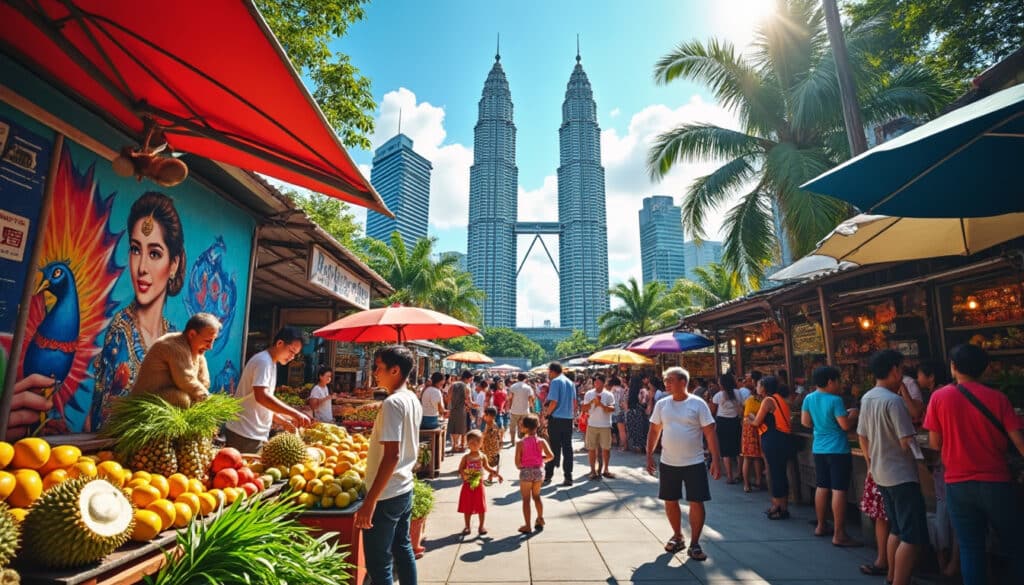
Culture & Local Life in Kuala Lumpur
The rich cultural tapestry of Kuala Lumpur reflects a unique confluence of histories, traditions, and contemporary vibrancy. As Malaysia’s bustling capital and economic heart, the city offers visitors an enticing mix of old-world charm and modern living. From the iconic…
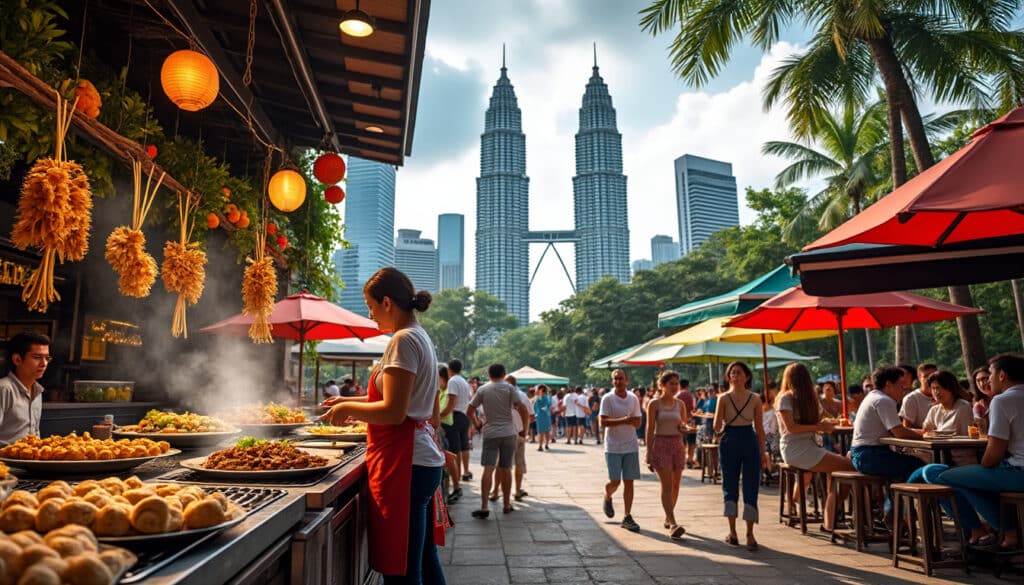
Best places to eat in Kuala Lumpur
Home to a rich tapestry of cultures, Kuala Lumpur is renowned for its culinary landscape that draws inspiration from Malay, Chinese, Indian, and even Western cuisines. This vibrant mix offers food lovers an unparalleled gastronomic experience, from bustling streets serving…
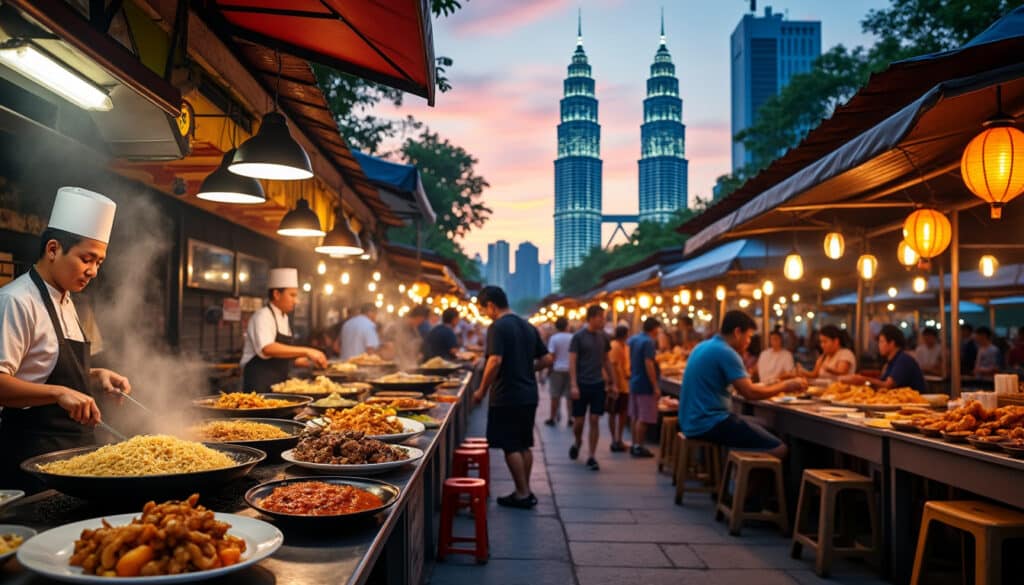
If there’s one city that truly encapsulates a melting pot of flavors, it’s Kuala Lumpur. Famous for its diverse culinary landscape, Kuala Lumpur offers food lovers a unique blend of Malay, Chinese, and Indian cuisine. As each meal unfolds, visitors…
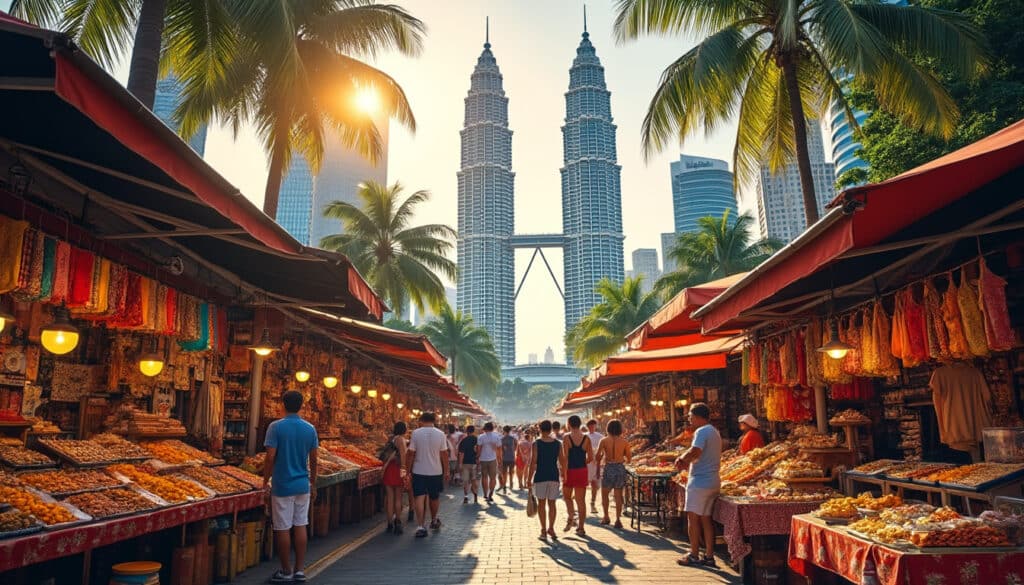
Souvenirs and shopping in Kuala Lumpur
Imagine stepping into the vibrant and bustling capital of Malaysia, Kuala Lumpur, a city renowned for its diverse cultural heritage and modern marvels. As you explore the streets, you find yourself surrounded by an enticing array of shops offering everything…
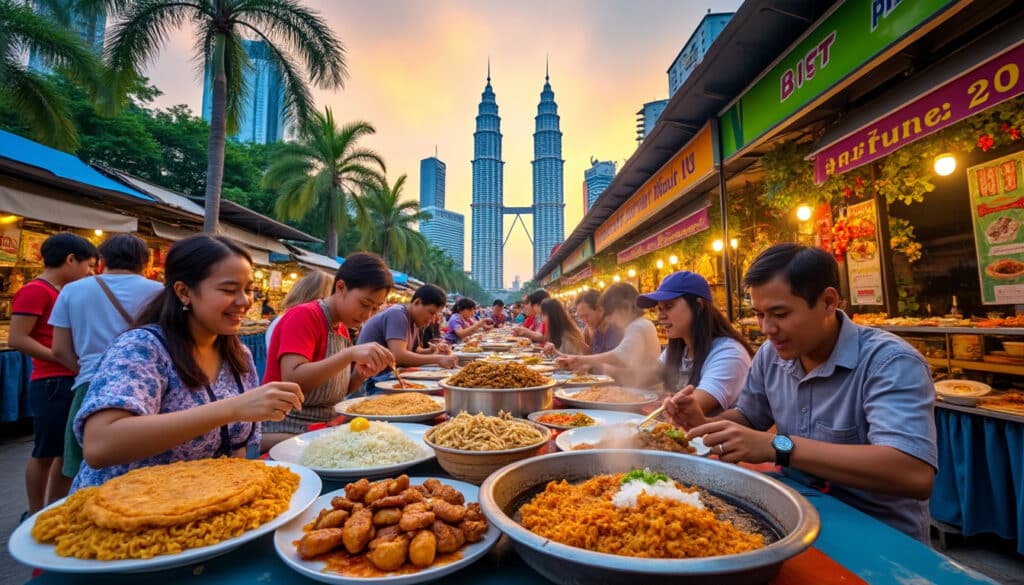
What do people eat in Kuala Lumpur?
Discovering the food landscape of Kuala Lumpur is akin to embarking on a tantalizing culinary journey where every corner reveals a new flavor, texture, and aroma. This vibrant city, a cultural melting pot with Malay, Chinese, Indian, and various other…


